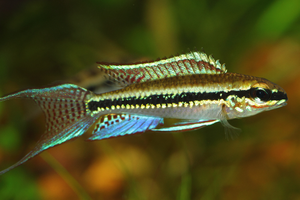Fork-tailed checkerboard cichlid
| Fork-tailed checkerboard cichlid | ||||||||||||
|---|---|---|---|---|---|---|---|---|---|---|---|---|

male |
||||||||||||
| Systematics | ||||||||||||
|
||||||||||||
| Scientific name | ||||||||||||
| Dicrossus filamentosus | ||||||||||||
| ( Ladiges , 1958) |
The fork-tailed checkerboard cichlid ( Dicrossus filamentosus , syn .: Crenicara filamentosa (Ladiges, 1958)) or checkerboard cichlid (Ladiges, 1958) is a small species from the family of cichlids .
description
The cylindrical, slender, brownish body of this cichlid has a checkerboard pattern. The caudal fin forks in the male lyre-shaped at the end into two long tips, in the female it is rounded, spade-shaped. Its checkerboard pattern in the color dress and the distinctive tail fin give the fish its name. The Latin epithet filamentosus ("provided with threads") probably also refers to the two-lipped caudal fin of the males. The sexually mature females can be recognized by their bright red pectoral fins. Overall, the females are a little more colorless than the males. Adult males reach a total length of about 9 cm, the females about 6 cm. Dicrossus filamentosus forms with D. maculatus and D. gladicauda the only representatives of this genus within the geophagines of South America .
Occurrence
In their natural biotopes , the fish live in very soft water ( ° dGH 1 = German total hardness) with a strongly acidic pH value (5.5) on a sandy bottom. Its natural habitat is in South America , the clear u. Blackwater rivers in the catchment area of the Rio Orinoco , the Rio Tapajós and the Rio Negro in Amazonia . In the Rio Tapajos, above the rapids, a previously undescribed Dicrossus sp. Kind exist.
Reproduction
Dicrossus filamentosus is considered polygamous and one of the non-cave-breeding species. The male keeps a harem of several females. Sexual maturity occurs at a length of 6 cm (males) and 4 cm (females). As a substrate spawner , the clutch is laid open (open breeder) on plant leaves at high temperatures between 28 and 30 ° C.
Aquaristics
Keeping and care
An aquarium with many plants and hiding places is just right for the approximately 8 cm tall, peaceful cichlid. However, this species makes high demands on the water quality. The species is shy and can be kept together with livebearers or tetras. Flake food is rarely used, Artemia is eaten with pleasure.
Legal regulation in Austria
In Austria, the minimum requirements for keeping fish are defined in Regulation 486 in Section 7 and its Annex 5. See also the Wikipedia entry ornamental fish .
Especially for the fork-tailed checkerboard cichlid, the following also applies: The fish must be kept in pairs. In addition, the following limit values must be observed:
| value | annotation | |
|---|---|---|
| Minimum size of the aquarium | 80 × 35 × 40 | Length × width × height in [cm] |
| Area for the water temperature | 23-30 | Degrees Celsius [° C] |
| Area for the water hardness | 0-15 | Degree of German total hardness [⁰dGH] |
| PH range | 5.0 - 7.0 | Acidity |
| Maximum value of nitrate | 50 | [mg / l] |
swell
- Horst Linke, Wolfgang Staeck, American Cichlids I. Small cichlids, Tetra Verlag, ISBN 3-8935-6153-6 .
- Günther Sterba : The world's freshwater fish. 2nd Edition. Urania, Leipzig / Jena / Berlin 1990, ISBN 3-332-00109-4 .
- Claus Schaefer: Dicrossus filamentosus. In: Claus Schaefer, Torsten Schröer (Hrsg.): The large lexicon of aquaristics. Eugen Ulmer, Stuttgart 2004, ISBN 3-8001-7497-9 , p. 326.
- Kullander, Sven, 1978, " A re-description of Crenicara filamentosa Ladiges, 1958 (Teleostei: Cichlidae)", Mitt. Hamb. Zool. Mus. htst., 75: pp 267-278
- DATZ 12/92: 767-770, Dicrossus sp. "Rio Negro",
Web links
- Fork-tailed checkerboard cichlid on Fishbase.org (English)
- A new checkerboard cichlid from the Rio Tapajós
Individual evidence
- ^ Rüdiger Riehl, Hans A. Baensch: Aquariums Atlas . Ed .: Hans A. Baensch. 15th edition. tape 1 . Mergus, Melle 2006, ISBN 3-88244-227-1 , pp. 696 .
- ↑ BGBl 486., 2nd Animal Husbandry Ordinance. Retrieved February 9, 2019 .
- ↑ a b BGBL II No. 486 Annex 5, minimum requirements for keeping fish. Retrieved February 9, 2019 .
